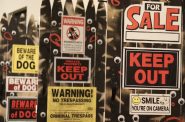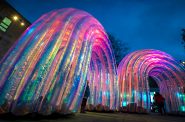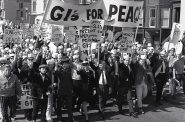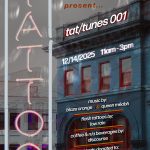Milwaukee Art Museum’s Grinning Chinese Warriors
Two arresting contemporary works in the Milwaukee Art Museum’s Summer of China exemplify the Spiritual and the Political, the two principal strains of contemporary art in China.
Zhan Wang’s Artificial Rock No. 43 is a monumental reflection upon on the venerable Chinese tradition of scholar’s rocks. A classic example stands at the entrance to The Emperor’s Private Paradise: Treasures from the Forbidden City now on exhibition at MAM. But Wang’s Rock is very much a masterpiece of our own time.
I viewed it in the company of chief curator Brady Roberts. We then headed to the latest addition to MAM’s Summer of China: Yue Minjun’s Chinese Contemporary Warriors, perfectly installed in the Lake Level contemporary art collection.
As we rounded the corner, the ranks of Warriors appeared as a startling force, lined up in perspective leading to the back of the gallery. (Around a half wall, Magdelena Abakanowicz’ headless burlap Two Figures on a Beam stand as a sly riff on Yue’s human forms). We walked among Yue’s slightly larger than life warriors. There is no avoiding visceral interaction with this strange army. These warriors, all stylized self-portraits of the artist cast in bronze from a single sculpture, vary only by their surface imperfections.
Their human scale is unnerving. The warriors’ jeans, a bit too long and so realistic you feel you could wear them, drape around enormous feet firmly planted on the low, square pedestals. Sleeveless undershirts stretched out at the neck are tucked into beltless pants. Muscled arms, a bit too large for the slender, human proportioned bodies, end in very large hands that reach up to cover the ears of the enormous round heads. The huge faces, with eyes squeezed shut, are overtaken by identical giant grins.
We’ve seen these smiles before. Yue Minjun, born in 1962, is internationally renowned primarily for his paintings of smiling self-portraits. He obviously refers to socialist realist art, the official style of communist totalitarian states everywhere. His satire is hard to miss.
In a 2007 interview with the New York Times’ Richard Bernstein, Yue said: “A smile doesn’t necessarily mean happiness; it could be something else.” The smile has been variously interpreted as a sort of joke at the absurdity of it all, or the illusion of happiness in lives inevitably heading toward extinction. Karen Smith, a Beijing expert on Chinese art, suggests that Yue’s grin masks feelings of helplessness. “In China there’s a long history of the smile,” Yue said. “There is the Maitreya Buddha who can tell the future and whose facial expression is a laugh. Normally there’s an inscription saying that you should be optimistic and laugh in the face of reality.”
The museum’s wall text puts it this way: “Mindlessly happy in their uniformity, the compliant citizens of this absurd army recall the famed terra-cotta warriors from Xian. Rather than the serious visages of the warriors, however, these figures convey ‘see no evil, hear no evil, speak no evil.’”
Roberts explained that this ancient saying probably originated in Japan, moved to China, where it customarily ends with “Do no evil.” “These warriors are completely silent, yet speak so loudly,” he said.
Roberts interprets the work as a satirical critique of the Chinese government. He sees Yue as stepping to the edge but not crossing the line of what the government considers illegal criticism. (Ai Weiwei, whose work Roberts had hoped to have in this show, famously crossed that line and was arrested in April.)
So far, Yue has been subtle enough to dodge official sanction. So, see no evil, hear no evil — but laugh in the face of absurdity.
Lee Ann Garrison is chairperson of the Department of Art and Design at the University of Wisconsin-Milwaukee.
Art
-
Winning Artists Works on Display
 May 30th, 2024 by Annie Raab
May 30th, 2024 by Annie Raab
-
5 Huge Rainbow Arcs Coming To Downtown
 Apr 29th, 2024 by Jeramey Jannene
Apr 29th, 2024 by Jeramey Jannene
-
Exhibit Tells Story of Vietnam War Resistors in the Military
 Mar 29th, 2024 by Bill Christofferson
Mar 29th, 2024 by Bill Christofferson























Itook my 11-year-old grandson for a stroll through the forest of Yue sculptures. He remarked that they resembled objects in the game, “Find
The Differences.” Artists, are they the few in China who dare to be different? We’re readubg this review together today, and then returning to MAM for another look.
[…] This week the Museum plays host to a few exciting events. On Thursday, July 21, the Museum welcomes Melissa Chiu, director and curator for contemporary Asian and Asian-American art at the Asia Society in New York. She’ll be giving a lecture at 6:15 p.m. in Lubar Auditorium about contemporary Chinese art. Stick around after the lecture and walk amongst the new installation by contemporary Chinese artist Yue Minjun. […]
I hope you bring a camera. Great photo ops!
Lee Ann
Great piece of writing, Lee Ann.
great synopsis.If you like Yue’s work and haven’t seen this, you should:
http://www.pbs.org/wnet/secrets/featured/chinas-terracotta-warriors-about-this-episode/812/
I remember during college there was the Little Red Book of Mao craze and lots of red posters with super-fat babies rolling around with peaches….I guess those babies have grown up!
Didn’t they release AiWeiWei in June?